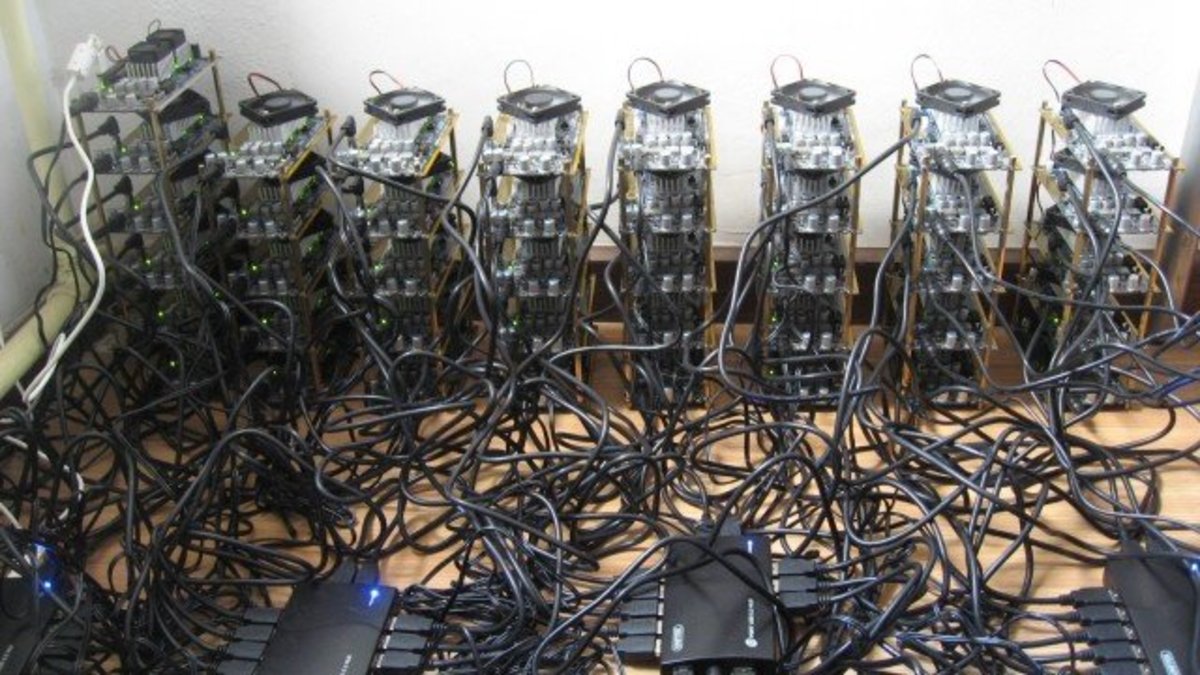
This was written in response to a piece written by Tim Fernholz about miners spending $17 million a day for a shot at $4.4 million of bitcoin. I do recommend reading his article on international money smuggling.
As wasteful as it sounds to spend $17 million a day to gain $4.4 million, this article is based on false data. Mining Bitcoins may use a boat load of electricity, but there are profitable miners out there unlike Tim’s article claims.
The data used in the article is from blockchain.info, a company near and dear to my heart, that provides a nice spread of Bitcoin services like wallet management & coin mixing services, block info, a well designed page for Bitcoin public addresses, and several charts and stats to help folks digest the complex and elegant solution to financial freedom that is Bitcoin.
It just so happens that Tim choose the most inaccurate piece of data on blockchain.info and I’ll illustrate why in just a second.
Bitcoin miners’ electricity use is quite high and miners don’t think twice about it. Well they start to reconsider when their profits are swallowed by electricity costs. And respond by either selling their miners to new Bitcoin users who have caught the Bitcoin mining bug or decide to repurpose their miners for the highly speculative market of mining Altcoins.
The rest of the info I present will show how truth is often in error when summarized by statistics and boiled down to one number. Here are some tables I whipped up showing the range of miners available to Bitcoin users with ASIC miners.
I’ve compiled a short list of miners from companies who have or claim to have miners on inventory. They have been seen in the wild and mining happily while Bitcoin enthusiasts around the world cheer them on or yell at them for not just buying Bitcoins with their money.
The first problem is assuming all miners use 650 Watts per gigahash. The nature of ASIC design is to manufacture more efficient ASIC over time increasing hashing power and use less electricity with each iteration. One year, a 65nm ASIC miner may very well draw 650 Watts, but the next generations of ASIC miners will get more efficient and could draw 550 Watts. This page of stats, to my knowledge, hasn’t been updated to reflect the latest miners that have come online in the past year.
Mining Company Released Miner Name Total Watts Used Miner Type ASIC width
KNCminer Jupiter1 550 Watts Sha256 28 nm
Butterfly Labs MiniRig 2400 Watts Sha256 65 nm
Avalon 4 Module 750 Watts Sha256 65 nm
ASICminer USB Block Eruptor .5 Watts Sha256 65 nm
Blockchain.info assumption n/a 650 Watts per gigahash n/a n/a
Table 1: I used http://mining.thegenesisblock.com/ for the miner information. The shipping dates and availability on this site is out of date, but the list of companies is comprehensive.
Here’s another table that shows the range of residential electricity rates in the United States and around the world [sources 12 href="https://web-beta.archive.org/web/20140123023211/http://shrinkthatfootprint.com/average-electricity-prices-kwh" rel="noopener external noreferrer"].
Location Electricity Rate (cents per kilaWattHour)
US, West South Central 10.91
US, South Atlantic 11.81
US, New England 17.4
US, Pacific Noncontiguous 29.04
India 8
China 8
France 19
Australia 29
Spain 30
Denmark 41
Table 2: Sample of International Electrical Costs within the past 2 years.
Denmark has a peculiar situation where households pay far more than the average business for electricity based on this published data which is based in Euros.
The second problem is the blockchain.info’s stat pegs the average electrical use to $0.15 per kilowatt. The table listing the electrical costs for various regions of the world clearly shows a miner’s location should be considered even before thinking about a miner. Certain towns have large corporations absorbing the lion’s share of the electrical costs. Others may use solar power or gas generators.
Here’s yet another table showing the data from the first table with the worst case scenario of the second table comparing the profitability of a miner in Denmark if they were to use any of the miners available right now.
Released Miner Name Total Watts Used Electricity Cost for a Denmark Miner over 1 month Estimated Monthly earnings with a 1 billion difficulty2
Jupiter 550 Watts $162.36, €118.02 7.8 BTC, $6856, €4972.80
MiniRig 2400 Watts $708.48, €515.00 7.2 BTC, $6317, €4581.85
4 Module 750 Watts $221.40, €160.94 1.29 BTC, $1132, €821.06
USB Block Eruptor 0.5 Watts $0.15, €0.11 .0048 BTC, $4.211, €3.05
blockchain.info’s estimate 650 Watts per gigahash $191.88, €139.48 Miners Monthly earnings > 0.2191 BTC to profit.
Table 3: Combination of Table 1 and 2
I found out the estimated profits by logging on to https://webchat.freenode.net/#and in the #kncminer channel is a bot called elwizbot. This bot is something special as it is the most accurate estimate and calculator of Bitcoin earnings per day and hour. I have no clue who wrote this bot or how it makes its calculations, but as each difficulty changes, its estimates based on the earnings from users on that irc chat and on KnCMiner forums are pretty accurate.
If you send elwizbot a certain command, it will give you estimated Bitcoin earnings.
}bc,genghestimate 550 The expected generation output, at 550 Ghps, given estimate upcoming difficulty of 1037702886.49098228 , is 0.266552987625 BTC per day and 0.0111063744844 BTC per hour.
The last table shows that even in Denmark, a miner could pay off their ridiculously high electric bill and afford to save Bitcoins at the same time. This profit is heavily dependant on price, but with the current prices crossing the $1,000 mark passed twice this year (currently lower now!), several miners have made enough to pay for their miner based on the accounts of some miners.
Even with the true cost being somewhat better than what is reported at blockchain.info, I don’t advocate going out and grabbing a miner (or paying for the promise of a future miner) this late in the game. I do hope anyone in the market for a miner would consider more than 1 statistic on 1 webpage. At least verify theBitcoin community’s results at the Bitcointalk mining forum and hear what others have said about their Bitcoin mining experience with miners and mining companies. It is important to know how reliable a company is, since some have gone bankrupt, have unrealistic delivery schedules, or encounter delays due to the complexity of manufacturing cutting edge ASIC technology.
Another argument against purchasing ASIC mining technology is the concept behind the difficulty of the Bitcoin network. The difficulty looks at the average time it takes to process a block from the blockchain and if it is under 10 minutes the difficulty goes up. If the time is over 10 minutes the difficulty drops. As the Bitcoin network grows the blocks will be processed faster and almost guarantee an increase in difficulty that makes it harder and harder to squeeze out Bitcoin mining rewards.
A more interesting topic would be to explore where the average miner gets their electricity. Looking past electric companies and into how their electricity is generated, whether it be from combustible fuels, nuclear, hydroelectric, geothermal, wind, or solar this would be a far more fruitful discussion to determine whether miners are feeding into the naughty (nuclear power) or nice (mining with solar power) ways of getting power to verify Bitcoin transactions.
Notes
1) I realize Jupiter is currently out of stock, but used this miner as an example of the most efficient miner. Theoretically this miner could be purchased second hand.
2) I also realize comparing the earnings over 1 month with a difficulty that adjusts every 2016 blocks or every 10-12 days is very futile. This is why I used the upcoming difficulty which will be around 1 billion and not the current difficulty of around 900 million.










